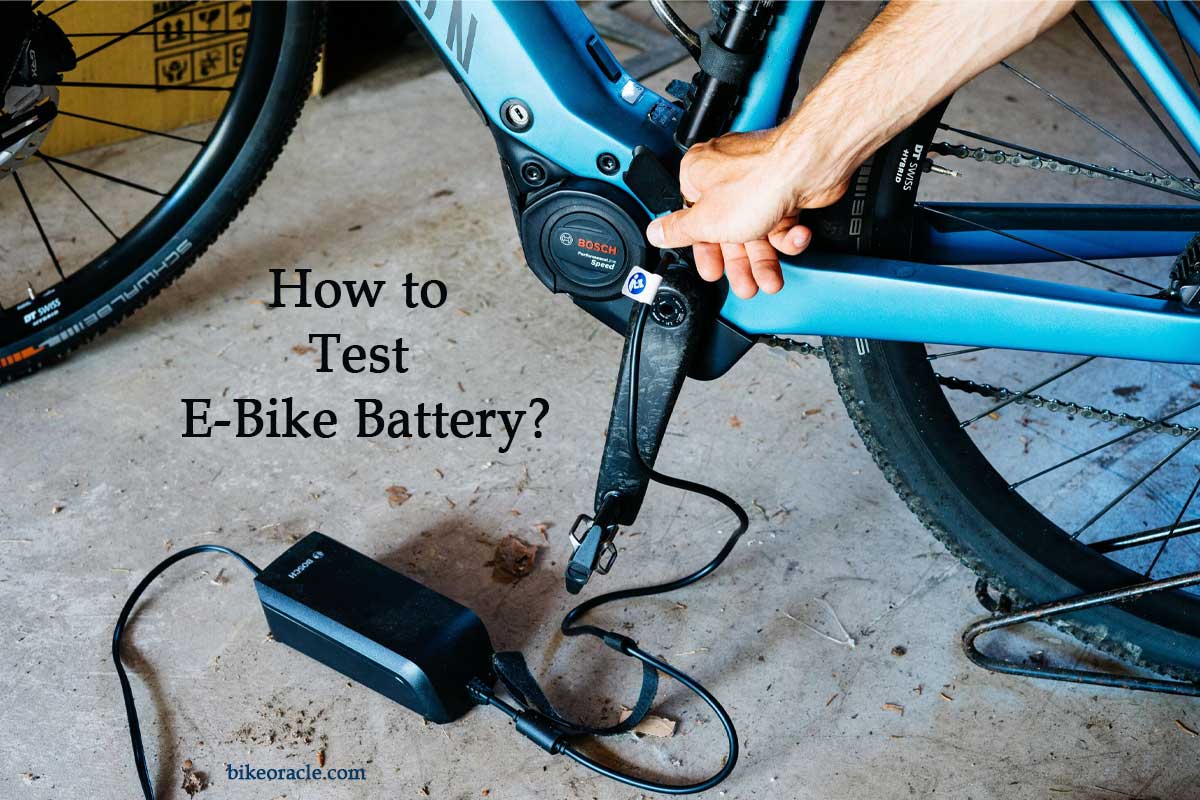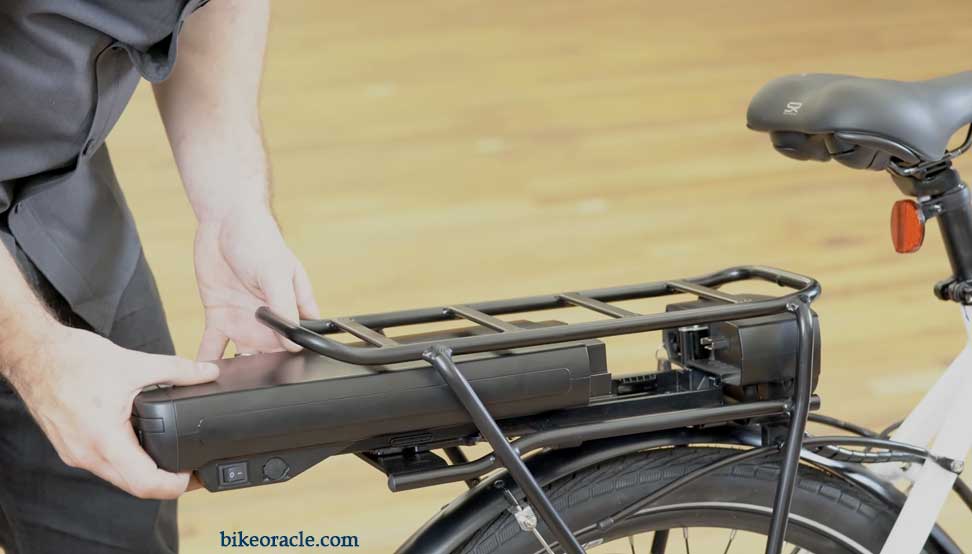How to Test E-Bike Battery – [Answered]

E-bike batteries are delicate, and charging them improperly could lead to overcharging or undercharging, reducing battery life. They also need regular maintenance once they’re in use. That’s why cyclists need to test their e-bike batteries before each ride and periodically check their voltage to prevent them from overcharging or undercharging.
Do you want to know how to test an e-bike battery? If you are stranded on a deserted island and need an electric bike to get around, there is no reason to be afraid because we have all the information you will need to test your battery. You only need a couple of things that most people would have at home.
Let’s take a look at what this post will cover and how you can test your e-bike battery if it has gone dead in the first place. We’ll also give some tips for making sure that it doesn’t happen again.
Types of E-bike battery test
There are two types of E-bike battery tests one is by the consumer end, and another is by the manufacturer end.
If you are a consumer or common person, you can test the battery with a multimeter and check the voltage, resistance, and ampere.
If the battery is tested at the manufacturer’s end, many tests have been made before launching the product in the market. For example, first, they test the battery at the cell level with a visual inspection, overcharge test, thermal runway test, short circuit test, impact test, and over-discharge test. Secondly, they test the battery at pack level with an external short circuit test, internal short circuit test, thermal cycling test, over-discharge test, impact test, and overcharge test.
How To Test Your Electric Bikes Battery?
Over the years, we have seen many electric bikes and scooters, but how do you test your battery? Here is a basic guide on how to test your bike’s battery. The articles will be about the following points:
Step 1: Connect the Multimeter.
Connect your battery charger to the multimeter and test wires. The red lead goes to the positive end of the battery; the black lead goes to the negative end.
Do a “cold” cycle test.
1A will drain one amp from a fully charged 12V 0Ah battery at 25 degrees Celsius to empty in 1 hour. 2A will do 2 amps at the same time.
Test the charger and battery before you begin. Do not let the battery go below 10V.
Step 2: Testing Load Battery.
Make sure you have 3-4 cells fully charged at 12V or more, and put it on your bike (if not, make sure you have a power supply or booster). If you do not have enough charged cells fully, connect your charger by its red and black wires to the batteries and see if there is voltage.
The bike light should turn on.
If voltage is not present, check the fuse, wiring and charger.
1A will drain one amp from a fully charged 12V 0Ah battery at 25 degrees Celsius to empty in 1 hour. 2A will do 2 amps at the same time.
Step 3: Test Voltage and Current.
Measure the voltage of your bike battery with a multimeter and write it down or check it on your phone app (I am using an Android phone).
The voltage will probably be around a 3.3V minimum to 8.4V maximum. It is ok for the voltage to vary slightly, but make sure it is not more than 3V or less than 1V. The tested battery could be good and fully charged, but the multimeter would read low voltage because the bike battery was taken out of use a few weeks before testing it.
It is normal for the voltage to spread or drop gradually when you are using your bike. For example, the voltages could be 3.5V during the ride and 3.4V after riding for a few minutes.
Measure the current of your bike battery with a multimeter and write it down or check it on your phone app (I am using an Android phone).
The current will probably be around 20-30mA minimum to 70-100mA maximum. It is ok for the current to vary slightly, but make sure it is not more than 10mA or less than 15mA. This will help prevent your battery and wiring from being damaged.
Step 4: Test the Resistance of the Battery
Examine your bike’s battery, especially it’s surface of it. You may find some bubbles or spots on it or a yellow film on the surface of your bike’s battery.
You may find battery resistance of 12.34 and 12.33 ohms too high. The resistance of your bike’s battery will be less than this because the voltage is low, but the resistance can easily be measured with a multimeter at room temperature, and the multimeter should read 12.5 to 13 ohms.
Check the connections to ensure no cracks or cuts on them or connectors.
Step 5: Checking the Battery with Charger
If your bike’s battery is good, yet the voltage and current are too low or too high, you could try to charge your bike battery. Note that the charger setting should be based on the voltage of your bike battery and not on its capacity.
Find a full-cell 12V battery that has a voltage reading above 8 volts. Connect the red lead on the multimeter to the negative end of this battery; the black lead goes to the positive end of this battery. Set your charger to charge your bike’s battery. Note that charging will take 1-4 hours. Check the voltage and current of your bike’s battery after the full charge. A fully charged 12V 0Ah bike battery should have a voltage of 12 to 14 volts and a current of 20-30mA or more.
Note that you can charge your bike battery with different chargers. You could test your bike’s battery with a 5A charger and see that the voltage drops to 10V and the current goes to 29mA, but then you could use a 2A charger and set it to 2A and see that the voltage goes to 12V and the current jumps to 42mA or more. After either of these tests, you should end up with a fully charged 12V 0Ah bike battery.
How To connect a multimeter to my type of battery?
If you’re not entirely sure what a multimeter is, it’s a measure of the voltage and current of your battery. It can also measure the resistance of a load, but that’s usually an optional feature.
The first step is to look at your battery and see which type it is (most batteries will have it printed on them). This will determine which function you’ll need your multimeter for.
For example, if you have a 4-cell AA battery pack:
If you’re using it to measure voltage, and it only has one terminal, then you’ll need to connect the black lead to the negative end of the battery and the red lead to the positive end. Make sure your multimeter is set at 0 volts (or milliVolts if your multimeter can go that low in voltage).
If you’re using it to measure resistance, connect the black lead to the negative terminal and the red to a point midway between two positive terminals. Make sure that your multimeter is set at 0 ohms.
If you’re using it to measure current, take the black lead and put it between one positive terminal and another point along one of them (not necessarily halfway). Then take a red lead and touch that end somewhere along a negative terminal (not necessarily halfway). And make sure that your multimeter is set to measure amps.
What are the signs of a bad battery?
From my own experience and from researching for this post, here are some common signs that your battery might be bad:
First and foremost, many people say their battery just stopped working suddenly. When you try to charge it, nothing happens.
The battery has a very high internal resistance and can’t be charged. It tries to charge, but the charger just won’t shut off. After hours of charging, it might go up 0.1-0.2V, but then it stops, and the charger still thinks it’s connected.
If you pull too much current out of the battery (consume power faster than you replace it), capacity decreases rapidly. This is also called “load line regulation” and is a fancy way of saying the battery no longer has enough capacity to supply you with all the power it’s being asked for.

The amount of usable power in the batteries drops once you start running the motor. Many e-bike systems can still be used if the motor doesn’t run, but efficiency decreases, making them less useful for long-distance travel. The high internal resistance is one reason some systems are not as efficient as others.
You might also notice that charging the battery and riding it simultaneously will cause the battery gauge in your computer to bounce around a lot. This is normal, but if you’re using a lead acid system, you want to try to charge it in an area that isn’t too humid or dry.
Think of your battery as an engine that’s been run for 100 miles and has been sitting for 2 months. It’s likely to be pretty cranky, and it will take a lot of effort to get it running again.
What should you do if your battery starts acting up?
There are a few things you can try. Some are probably worth trying before any other thing, and some might even be the only thing that fixes your problem.
First, try charging it with a different charger. If you have another bike and a friend who has one, try borrowing their charger. The plug is different, so you’ll need an adapter.
Some people have had luck bringing batteries back to life by running them in a tire swing. I have no idea why this works, but the swinging motion helps mix the electrolyte and get it moving inside the battery.
You can also try some UV treatments. I don’t know if this works, but it sounds cool!
If you can’t find any of these, or they don’t help, the most likely thing that might cause your battery to be bad is that it’s no longer charged. If this is the case, you should probably get a new one.
With lead-acid batteries, there are some basic things to understand. These are covered in many places online, so I’ll give a brief list here.
The most important thing is to ensure you have good connections between the battery and the rest of your system. Check those with a voltmeter or an ohmmeter. They can cause problems like an unbalanced voltage and poor performance if they’re not good.
Many people have trouble charging their lead acid batteries using their wall outlet. Most people think they should charge a 12V lead acid battery at 14.5V, but this is incorrect. A good place to read up on this is the Lunacycle blog. They have an entire page about this topic and links for further reading.
The other thing to try if you’re trying to charge your lead acid battery with a wall outlet is to slow down the charging rate. The standard rate is 1C, meaning your battery should be charged at 14.5V and be charging for 14 hours. Try to slow down the charging rate to 0.5C and see how that works.
If you don’t have much experience with lead-acid batteries, I suggest not overcharging them by more than 20%. This will cause them to become permanently damaged and won’t be covered by your warranty.
The other important thing is ensuring your battery isn’t too deeply discharged. A deep discharge cycle can cause significant damage to the lead-acid batteries used in e-bike systems. It may be a good idea to ride it a little before you look at the battery to get an idea of how well it works.
Final words
The best electric bicycle will become useless if something bad happens to the battery. Overheating is one of many conditions that can damage the battery. It will permanently damage the battery, and my friend said, “it’s not a good idea to ride your E-Bike on a damaged battery”. E-bike batteries should be tested periodically to make sure they are in top form and ready for the new year. The best way to do this is by performing a load test on them. The load test can be done with a watt meter and a voltmeter. It will show you how efficient your batteries are at delivering power to the motors when in use, which are the most important part of an e-bike. The information gathered from the tests will help you choose new accessories for your bike, or make changes to improve their performance even more.


![Are E-Bikes Considered Motorized Vehicles? [Answered]](https://bikeoracle.com/wp-content/uploads/2023/10/Are-E-Bikes-Considered-Motorized-Vehicles-768x403.jpg)
![How to Remove Speed Limiter on Electric Bike? [Answered]](https://bikeoracle.com/wp-content/uploads/2023/09/How-to-Remove-Speed-Limiter-on-Electric-Bike-768x512.jpg)

